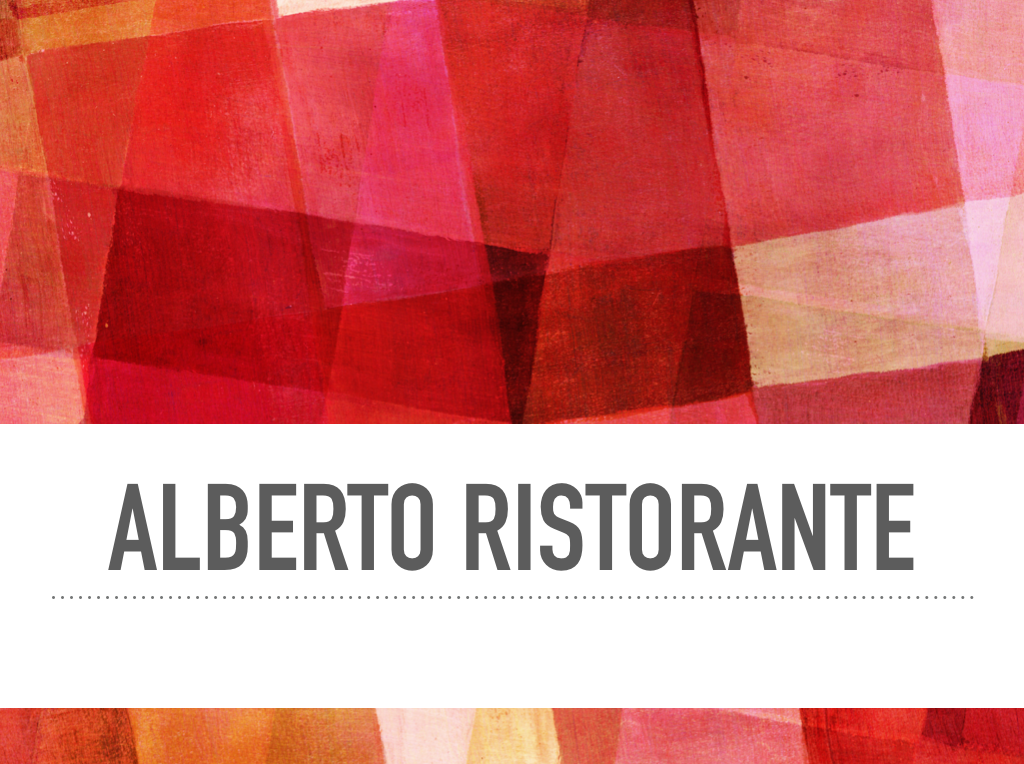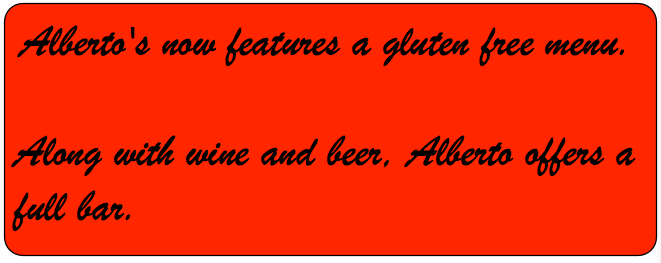Fine Italian cuisine meets warm hospitality at Alberto’s Ristorante, a staple of Carefree’s dining scene. Owned and operated by Chef Alberto Liani, who was born and raised in Rome, this intimate restaurant brings an authentic Italian experience to the desert, complete with handcrafted dishes, an extensive wine selection, and a wood-fired pizza oven.
Chef Alberto’s passion for food began in his mother’s kitchen and flourished in Italy’s top culinary schools. His menu reflects that expertise, offering everything from antipasto and fresh seafood to house-made pasta and slow-braised meats made with all the finest ingredients. And for those looking for something truly special, Chef Alberto himself will personally craft a dish just for you.
A meal at Alberto’s is more than just dinner—it’s an experience. The restaurant’s warm, inviting atmosphere makes it the perfect place for a romantic evening, a family gathering, or a night out with friends. Pair your meal with a selection from their carefully curated wine list, which includes Alberto’s own private collection, and don’t leave without trying the house-made tiramisu or cannoli for dessert.
Chef Alberto’s passion for food began in his mother’s kitchen and flourished in Italy’s top culinary schools. His menu reflects that expertise, offering everything from antipasto and fresh seafood to house-made pasta and slow-braised meats made with all the finest ingredients. And for those looking for something truly special, Chef Alberto himself will personally craft a dish just for you.
A meal at Alberto’s is more than just dinner—it’s an experience. The restaurant’s warm, inviting atmosphere makes it the perfect place for a romantic evening, a family gathering, or a night out with friends. Pair your meal with a selection from their carefully curated wine list, which includes Alberto’s own private collection, and don’t leave without trying the house-made tiramisu or cannoli for dessert.
📍 Where: 7171 E. Cave Creek Rd., Carefree, AZ
📞 Call: (480) 488-5800
🌐 Website: albertocarefreeaz.com
For a true taste of Italy right in Carefree, stop by Alberto’s Ristorante—where every guest is treated like family! 🍷🍝
📞 Call: (480) 488-5800
🌐 Website: albertocarefreeaz.com
For a true taste of Italy right in Carefree, stop by Alberto’s Ristorante—where every guest is treated like family! 🍷🍝

Phone: 480-488-5800
Address: 7171 E. Cave Creek Rd.
Carefree, AZ 85377
Carefree, AZ 85377
Email: mar3@cox.net
Hours: Tuesday - Saturday: 4:00 PM until patrons finish
Alberto Ristorante from Herbert Hitchon on Vimeo.
Porchetta from Herbert Hitchon on Vimeo.
Alberto Ristoranti from Herbert Hitchon on Vimeo.
Book a special event with Alberto
480-488-5800
480-488-5800
Dario Soldan: Beer - Menabrea & Bill Rumbolz: Wine - Caldora
ITALIAN MEDITERRANEAN CUISINE
Facts and Recipes
INTRODUCTION
MANGIA BENE! VIV BENE! These Italian words mean “Eat Well!” and “Live Well,” phrases that perfectly describe the Mediterranean Diet - the Italian way of eating that is at once delicious and extremely nutritious.
Cucina Italiana! is a celebration of the joys and healthfulness of Italian Mediterranean cuisine. It is a campaign sponsored by the Italian Trade Commission that is designed to make the “gourmet” in you more aware and appreciate of the wonderful foods and wines from Italy!
THE HISTORY OF ITALIAN MEDITERRANEAN CUISINE
It was actually an American, Ancel Keys, M.D., who first made the connection that the Mediterranean Diet - which has strong traditions in Italy - led to extremely low rates of heart disease, cancer, obesity, diabetes, and arteriosclerosis among the Mediterranean basin populations. So strong was the link between the way these people regularly ate and the low disease rates, that Dr. Keys launched an official study of seven countries throughout the world.
His findings were clear: The nutritive habits of the Mediterranean Region, which trace back to the ancient eating habits of the southern Italian farmers, were considered the ideal in order to maintain good health and a long life.
The staples of this diet are pasta, olive oil, cheese, fruits and vegetables, legumes, wine, and of course, the infinite variety of seafood from the rich Mediterranean Sea.
Pasta is rich in vegetable protein, Vitamin B, niacin, iron and phosphorous. Olive oil is an unsaturated vegetable fat that is easy to digest and believed to postpone the signs of aging. The cheeses of the Italian Mediterranean region are diverse and flavorful, and come primarily from the milk of cows, sheep, and goats.
The fruits and vegetables indigenous to the region include oranges, apples, grapes, pears, spinach, broccoli, Savoy, and cabbage – all very rich in Vitamin A, Vitamin C, and Vitamin E. The legumes – broad beans, lentils, garbanzo beans, peas, and lupines – have the capacity to reduce cholesterol in the blood.
The modest consumption of wine (especially red) has a preventative action against cardiovascular disease. And seafood, especially the abundant blue fish (anchovies, herring, sardines, tuna) are rich in unsaturated fats called the Omega-3’s that help prevent blood clot formation, a major cause of heart attacks.
No wonder the ails of ill health are so rare in this part of the world!
The good news for all of us is that the typical and delicious Mediterranean Diet of Italy embodies the ideal nutritional goals set by experts in the U.S.
So for healthful and delicious eating, consider imported foods from Italy. There are simple, fresh and natural. Take a cue from the centuries of common sense in the Italian attitude towards proper diet, combined with an equally long devotion to quality and taste appeal.
And now more about “the staples” – pasta, cheese, olive oil and wine . . .
PASTA
If it’s pasta, it must be fattening, right? WRONG! Pasta is one of the world’s perfect foods.
It is low in fat and high in digestibility. Four ounces of cooked pasta contain just 210 calories, about the same as two small apples.
An energy-giving carbohydrate, it also contains more protein (13 percent) than potatoes. Four ounce of cooked pasta has all of the U.S. recommended daily allowances for adults of vitamins and iron.
ENERGY BUILDING
Termed a complex carbohydrate by nutritionists, pasta has recently become the favorite of athletes and anyone else seeking more physical and mental energy. Calling pasta intake “carbo loading”, they have discovered that the body stores the energy-giving carbohydrate in pasta more readily than in any other form. Thus, the body can draw upon it for a greater length of time.
L.A. Marathon runners eat it for two or three days before the race, and a free pasta dinner for all contestants the night before the race is becoming a tradition.
NUTRITIONAL EXCELLENCE
In addition to energy, pasta provides six of the eight essential amino acids. The standard sauces that we all love provide the other two and the combinations are a nutritionist’s dream for what’s good for you.
UNIVERSAL APPEAL
And pasta has one quality that we all know. Everyone loves it!
THE CHEESES OF ITALY
From its northernmost Alpine stretches to its nearly tropical islands, Italy is thoroughly a cheese-making land. Everywhere the farms of Italy, steeped in cheese making traditions for thousands of years, transform the mild of cows, sheep, goats or even buffalo, into completely natural, totally individual and simply delicious cheeses.
From creamy, soft cheeses to aromatic, aged hard types, Italy’s cheeses reflect the quality, variety and style so characteristic of everything Italian.
A Gourmet Delight
The N.Y. Times recently wrote, “Americans are discovering the world of Italian cheese . . . delicious cheese of incredible richness and fascinating nuance.” In their endless ranges of styles and flavors, Italy’s cheeses are the world’s most exciting. Exploring them can be a real adventure for the palate and the soul alike.
Available Everywhere
More than 150 cheeses from Italy are now available in the United States, making up a diverse collection of fresh, soft ripened and semi ripened and semisoft treats. They range from the buttery, delicate, nutty Mascarpone to pungent Gorgonzolas, toe the straw colored Paglietta, which tastes like a cross between a perfectly ripened
Brie and Camembert.
OLIVE OIL
Italian olive oil has always been prized in the kitchens of great continental restaurants, but it is only recently that Americans have discovered the health benefits and taste delights of Italy’s olive oils.
Since olives from Italy generally contain more oil than those from other Mediterranean areas, they contain a flavor that surpasses others.
American consumers have made Italian brands the most popular imports. Due to this demand, we can now choose from many types and qualities of Italian olive oils.
Strict Controls
In Italy, the production of olive oil is overseen with the strictest of regulations typical of fine wine. Production and sales are controlled by statutes requiring that all products pass government inspection.
Extra virgin olive oil is the best and most expensive grade, since its production is so carefully watched and almost entirely done by hand. Lesser grades of virgin oil are produced by further pressing of the same oils at higher pressures. Italian olive oil is so rich and flavorsome that there are grades to fit every budget and every taste.
Health Benefits
In addition to wonderful flavor, the nutritional benefits of olive oil are surprising and fascinating. Containing iron and Vitamin A, olive oil is closest in chemical composition to the fat in human milk, making it the most digestible and easily assimilated of all fats and oils.
Also, since olive oil contains no cholesterol, its use on a regular basis is considered a valuable contribution to maintaining good cardiovascular condition.
This good news is just another reason to explore and enjoy the wide variety of Italian olive oils now available to you.
WINE
With the slogan “Alcohol sweeps clean the arteries” (if taken in moderate doses), wine has been absolved of many accusations, and its effects have been reevaluated. Wine, traditionally a Mediterranean and in particular Italian drink, must be considered in all ways a food. When taken in adequate doses – whether for its energy contribution or its 350 actually known components, wine has all the necessary qualifications to occupy a permanent place on everybody’s dining table.
Apart from ethyl alcohol, water, sugars, nitrogenous substances, vitamins and minerals, wine contains a series of compositions that ware it specific characteristics, such as taste, aroma, richness and bouquet.
The relationship between the consumption of wine and health is strictly linked to the concept of use versus abuse: It is apparent from analyzing the results of recent research conducted in African that it is better to drink a little wine than none at all.
The consumer must, however, always distinguish between wine and other alcohol based drinks.
According to some studies compiled in the United States at the Sinai School of Medicine, the modest consumption of alcohol (especially red wine) has a preventative action against cardiovascular disease. In short, a glass of wine even helps the elderly, if not in excess. According to very recent studies, not all alcoholic drinks have the safe effect: assuming the risk of heart attack for nondrinkers is equal to 1, moderate drinkers lower their average risk to 0.6; those who drink wine lower the risk to 0.4, while for beer drinkers the risk remains at 0.8 and hard liquor drinkers at 0.9. To attain the full beneficial effects upon the body, the recommended portions of wine should be consumed on a full stomach.
Facts and Recipes
INTRODUCTION
MANGIA BENE! VIV BENE! These Italian words mean “Eat Well!” and “Live Well,” phrases that perfectly describe the Mediterranean Diet - the Italian way of eating that is at once delicious and extremely nutritious.
Cucina Italiana! is a celebration of the joys and healthfulness of Italian Mediterranean cuisine. It is a campaign sponsored by the Italian Trade Commission that is designed to make the “gourmet” in you more aware and appreciate of the wonderful foods and wines from Italy!
THE HISTORY OF ITALIAN MEDITERRANEAN CUISINE
It was actually an American, Ancel Keys, M.D., who first made the connection that the Mediterranean Diet - which has strong traditions in Italy - led to extremely low rates of heart disease, cancer, obesity, diabetes, and arteriosclerosis among the Mediterranean basin populations. So strong was the link between the way these people regularly ate and the low disease rates, that Dr. Keys launched an official study of seven countries throughout the world.
His findings were clear: The nutritive habits of the Mediterranean Region, which trace back to the ancient eating habits of the southern Italian farmers, were considered the ideal in order to maintain good health and a long life.
The staples of this diet are pasta, olive oil, cheese, fruits and vegetables, legumes, wine, and of course, the infinite variety of seafood from the rich Mediterranean Sea.
Pasta is rich in vegetable protein, Vitamin B, niacin, iron and phosphorous. Olive oil is an unsaturated vegetable fat that is easy to digest and believed to postpone the signs of aging. The cheeses of the Italian Mediterranean region are diverse and flavorful, and come primarily from the milk of cows, sheep, and goats.
The fruits and vegetables indigenous to the region include oranges, apples, grapes, pears, spinach, broccoli, Savoy, and cabbage – all very rich in Vitamin A, Vitamin C, and Vitamin E. The legumes – broad beans, lentils, garbanzo beans, peas, and lupines – have the capacity to reduce cholesterol in the blood.
The modest consumption of wine (especially red) has a preventative action against cardiovascular disease. And seafood, especially the abundant blue fish (anchovies, herring, sardines, tuna) are rich in unsaturated fats called the Omega-3’s that help prevent blood clot formation, a major cause of heart attacks.
No wonder the ails of ill health are so rare in this part of the world!
The good news for all of us is that the typical and delicious Mediterranean Diet of Italy embodies the ideal nutritional goals set by experts in the U.S.
So for healthful and delicious eating, consider imported foods from Italy. There are simple, fresh and natural. Take a cue from the centuries of common sense in the Italian attitude towards proper diet, combined with an equally long devotion to quality and taste appeal.
And now more about “the staples” – pasta, cheese, olive oil and wine . . .
PASTA
If it’s pasta, it must be fattening, right? WRONG! Pasta is one of the world’s perfect foods.
It is low in fat and high in digestibility. Four ounces of cooked pasta contain just 210 calories, about the same as two small apples.
An energy-giving carbohydrate, it also contains more protein (13 percent) than potatoes. Four ounce of cooked pasta has all of the U.S. recommended daily allowances for adults of vitamins and iron.
ENERGY BUILDING
Termed a complex carbohydrate by nutritionists, pasta has recently become the favorite of athletes and anyone else seeking more physical and mental energy. Calling pasta intake “carbo loading”, they have discovered that the body stores the energy-giving carbohydrate in pasta more readily than in any other form. Thus, the body can draw upon it for a greater length of time.
L.A. Marathon runners eat it for two or three days before the race, and a free pasta dinner for all contestants the night before the race is becoming a tradition.
NUTRITIONAL EXCELLENCE
In addition to energy, pasta provides six of the eight essential amino acids. The standard sauces that we all love provide the other two and the combinations are a nutritionist’s dream for what’s good for you.
UNIVERSAL APPEAL
And pasta has one quality that we all know. Everyone loves it!
THE CHEESES OF ITALY
From its northernmost Alpine stretches to its nearly tropical islands, Italy is thoroughly a cheese-making land. Everywhere the farms of Italy, steeped in cheese making traditions for thousands of years, transform the mild of cows, sheep, goats or even buffalo, into completely natural, totally individual and simply delicious cheeses.
From creamy, soft cheeses to aromatic, aged hard types, Italy’s cheeses reflect the quality, variety and style so characteristic of everything Italian.
A Gourmet Delight
The N.Y. Times recently wrote, “Americans are discovering the world of Italian cheese . . . delicious cheese of incredible richness and fascinating nuance.” In their endless ranges of styles and flavors, Italy’s cheeses are the world’s most exciting. Exploring them can be a real adventure for the palate and the soul alike.
Available Everywhere
More than 150 cheeses from Italy are now available in the United States, making up a diverse collection of fresh, soft ripened and semi ripened and semisoft treats. They range from the buttery, delicate, nutty Mascarpone to pungent Gorgonzolas, toe the straw colored Paglietta, which tastes like a cross between a perfectly ripened
Brie and Camembert.
OLIVE OIL
Italian olive oil has always been prized in the kitchens of great continental restaurants, but it is only recently that Americans have discovered the health benefits and taste delights of Italy’s olive oils.
Since olives from Italy generally contain more oil than those from other Mediterranean areas, they contain a flavor that surpasses others.
American consumers have made Italian brands the most popular imports. Due to this demand, we can now choose from many types and qualities of Italian olive oils.
Strict Controls
In Italy, the production of olive oil is overseen with the strictest of regulations typical of fine wine. Production and sales are controlled by statutes requiring that all products pass government inspection.
Extra virgin olive oil is the best and most expensive grade, since its production is so carefully watched and almost entirely done by hand. Lesser grades of virgin oil are produced by further pressing of the same oils at higher pressures. Italian olive oil is so rich and flavorsome that there are grades to fit every budget and every taste.
Health Benefits
In addition to wonderful flavor, the nutritional benefits of olive oil are surprising and fascinating. Containing iron and Vitamin A, olive oil is closest in chemical composition to the fat in human milk, making it the most digestible and easily assimilated of all fats and oils.
Also, since olive oil contains no cholesterol, its use on a regular basis is considered a valuable contribution to maintaining good cardiovascular condition.
This good news is just another reason to explore and enjoy the wide variety of Italian olive oils now available to you.
WINE
With the slogan “Alcohol sweeps clean the arteries” (if taken in moderate doses), wine has been absolved of many accusations, and its effects have been reevaluated. Wine, traditionally a Mediterranean and in particular Italian drink, must be considered in all ways a food. When taken in adequate doses – whether for its energy contribution or its 350 actually known components, wine has all the necessary qualifications to occupy a permanent place on everybody’s dining table.
Apart from ethyl alcohol, water, sugars, nitrogenous substances, vitamins and minerals, wine contains a series of compositions that ware it specific characteristics, such as taste, aroma, richness and bouquet.
The relationship between the consumption of wine and health is strictly linked to the concept of use versus abuse: It is apparent from analyzing the results of recent research conducted in African that it is better to drink a little wine than none at all.
The consumer must, however, always distinguish between wine and other alcohol based drinks.
According to some studies compiled in the United States at the Sinai School of Medicine, the modest consumption of alcohol (especially red wine) has a preventative action against cardiovascular disease. In short, a glass of wine even helps the elderly, if not in excess. According to very recent studies, not all alcoholic drinks have the safe effect: assuming the risk of heart attack for nondrinkers is equal to 1, moderate drinkers lower their average risk to 0.6; those who drink wine lower the risk to 0.4, while for beer drinkers the risk remains at 0.8 and hard liquor drinkers at 0.9. To attain the full beneficial effects upon the body, the recommended portions of wine should be consumed on a full stomach.










